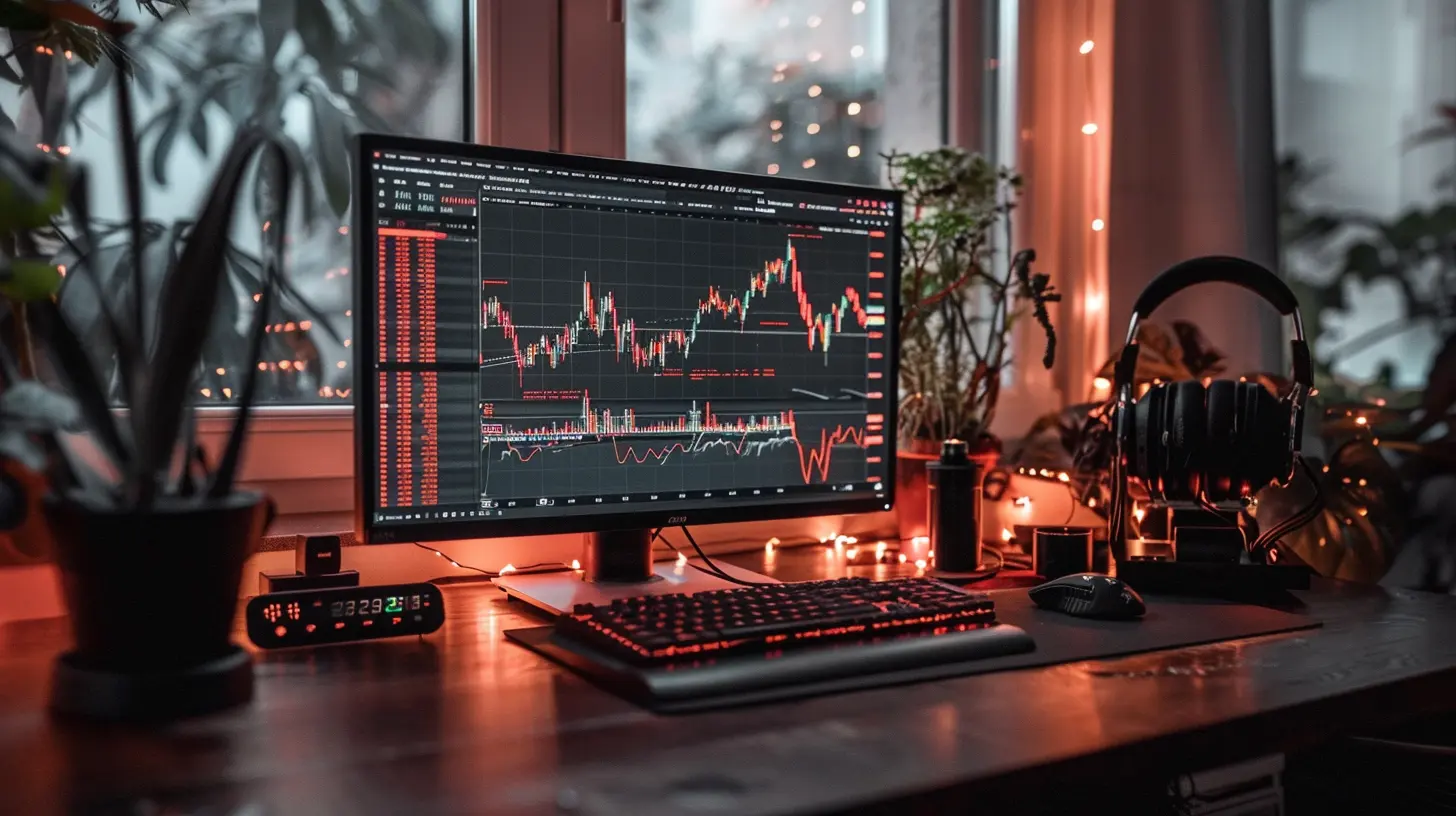How to Evaluate ETF Liquidity Before Investing
5 December 2024
Investing in ETFs (Exchange-Traded Funds) has become increasingly popular because they’re like a buffet of investments—stock, bonds, commodities—all rolled into one. They're cost-effective, offer diversification, and are generally easier to trade compared to mutual funds. Sounds great, right? But before you dive headfirst into this inviting buffet, there's one key metric you should always check: liquidity.
Why? Imagine trying to sell your favorite collectible item only to find no buyers willing to pay for it. That’s what it feels like when you invest in an ETF with poor liquidity. It can lead to higher trading costs and potentially hurt your returns. So, how exactly do you evaluate ETF liquidity before investing? Let’s break it down step by step. 
What is ETF Liquidity, and Why Does It Matter?
Before we get into the nitty-gritty of evaluating liquidity, let’s first understand what it is. Liquidity, in simple terms, is how quickly and easily an asset can be bought or sold without impacting its price.For ETFs, liquidity boils down to two key components:
1. Primary Market Liquidity: This refers to the liquidity of the ETF's underlying assets (the stocks, bonds, or other assets it holds).
2. Secondary Market Liquidity: This is about how frequently the ETF itself is traded on the stock exchange.
Why does liquidity matter? Let’s use an analogy: Liquidity is like having an "Exit" sign above your investments. The more liquid an ETF, the faster and smoother your exit. If the ETF isn’t liquid, you may end up paying a higher price to buy or a lower price to sell due to wider bid-ask spreads. Ouch, right? 
A Step-by-Step Guide to Evaluating ETF Liquidity
1. Check the ETF’s Average Daily Trading Volume
One of the easiest ways to assess liquidity is by looking at the ETF’s average daily trading volume (ADTV). This metric shows how often shares of the ETF are traded on the stock exchange.- High Trading Volume: Indicates strong secondary market liquidity. ETFs with high volumes are easier to buy and sell without significantly affecting the price.
- Low Trading Volume: This isn’t always a dealbreaker, but it does mean you need to dig deeper into the ETF’s structure.
? Pro Tip: Look for ETFs with at least 100,000 shares traded daily. This typically ensures decent secondary market liquidity.
2. Analyze the Bid-Ask Spread
The bid-ask spread is the difference between what buyers are willing to pay (bid) and what sellers are asking for (ask). Think of it as the cost of doing business. A narrow spread means you'll pay less to buy or sell, while a wide spread can eat into your profits.- Narrow Spread: Indicates high liquidity and lower trading costs.
- Wide Spread: May suggest poor liquidity or inefficiencies in the market.
How do you check the spread? Most broker platforms or financial websites will display this information alongside the ETF’s price.
3. Look at the ETF’s Underlying Assets
An ETF's liquidity isn’t just about how often the ETF itself is traded; it also depends on the liquidity of the assets it holds.Here’s the rule of thumb: If the underlying assets are liquid, the ETF is likely to be liquid, too.
- ETFs holding large-cap stocks or government bonds usually have higher liquidity because their underlying assets are widely traded.
- Conversely, ETFs focused on emerging markets, niche sectors, or exotic investments (like rare commodities) may face liquidity issues.
? Quick Example:
- Stock ETF (e.g., S&P 500 ETF): Underlying assets (large-cap stocks) are highly liquid = High ETF liquidity.
- Exotic Commodity ETF (e.g., Rare Earth Metals ETF): Underlying assets are less liquid = Lower ETF liquidity.
4. Understand the Creation/Redemption Mechanism
Wait, what’s that? The creation/redemption mechanism is one of the coolest things about ETFs. In the primary market, ETF managers “create” or “redeem” shares based on demand.This process helps provide liquidity even if the ETF’s trading volume is low. So even if you don’t see a ton of activity in the secondary market, it doesn’t mean the ETF is illiquid—thanks to this mechanism.
? However, the efficiency of this mechanism depends on the liquidity of the underlying assets. If those assets are tricky to buy or sell, it can affect the ETF’s overall liquidity.
5. Examine the ETF’s Total Assets Under Management (AUM)
While liquidity isn’t directly tied to an ETF’s AUM, size can still matter. ETFs with larger AUM are generally more liquid because there’s a higher likelihood of active trading.- Small AUM (<$100 million): Potential red flag, as low-interest ETFs may struggle to attract market makers.
- Large AUM (>$1 billion): Safer bet, as these ETFs are more established and actively traded.
6. Research the Market Makers and Authorized Participants (APs)
Market makers and APs play a huge role in keeping ETFs liquid. They’re like the backstage crew at a concert, ensuring everything runs smoothly.- Market Makers: Provide buy/sell quotes to maintain liquidity in the secondary market.
- APs: Create/redeem ETF shares to balance supply and demand in the primary market.
? If an ETF has a strong network of market makers and APs, it’s likely to be more liquid.
7. Check the ETF’s Price vs. NAV
An ETF’s price should closely match its Net Asset Value (NAV), which is the value of its underlying assets. If the price deviates significantly from the NAV, it could indicate liquidity issues.- Premium: ETF price is higher than NAV.
- Discount: ETF price is lower than NAV.
This typically happens in less liquid ETFs or during periods of market turbulence. 
Common Mistakes to Avoid When Evaluating Liquidity
1. Focusing Only on Trading Volume: Don’t let low trading volume scare you away without checking primary market liquidity.2. Ignoring Bid-Ask Spreads: These tiny gaps can add up, especially if you’re a frequent trader.
3. Overlooking Niche ETFs: Niche or thematic ETFs can be exciting but often come with lower liquidity. Always weigh the risks.
4. Forgetting the Creation/Redemption Mechanism: Just because an ETF has low secondary market liquidity doesn’t mean it’s a bad investment.

Wrapping It All Up
Liquidity might not be the flashiest factor when choosing an ETF (we get it, expense ratios and performance tend to steal the spotlight), but it’s just as important—if not more. Poor liquidity can lead to higher trading costs, delays, and ultimately, lower returns on your investment.By focusing on metrics like trading volume, bid-ask spreads, underlying asset liquidity, and AUM, you can confidently evaluate ETF liquidity before taking the plunge. Think of it as a way to ensure you’re not stuck in a traffic jam when you’re ready to exit your investment.
So, next time you’re eyeing an ETF, take a moment to assess its liquidity. Trust me—you’ll thank yourself down the road.
all images in this post were generated using AI tools
Category:
Etf InvestingAuthor:

Angelica Montgomery
Discussion
rate this article
17 comments
Zarenith McGovern
This article highlights the crucial aspects of evaluating ETF liquidity, such as trade volume and bid-ask spreads. It’s a timely reminder that understanding liquidity can significantly impact investment outcomes. I appreciate the practical tips provided for making informed decisions in the ETF market.
March 8, 2025 at 1:43 PM

Angelica Montgomery
Thank you for your feedback! I'm glad you found the article helpful in understanding ETF liquidity and its impact on investment decisions.
Sorin Wallace
Great article! Understanding ETF liquidity is so crucial for smart investing. Your insights provide valuable guidance for newcomers and seasoned investors alike. Looking forward to more informative content like this!
February 2, 2025 at 11:41 AM

Angelica Montgomery
Thank you for your kind words! I'm glad you found the article helpful. Stay tuned for more insights on investing!
Harrison Sanders
Evaluating ETF liquidity isn't rocket science—if you’re still scratching your head, maybe investing isn't your forte. Dive deep, know the spreads, and stop letting your money sit idle. Remember, fortune favors the informed investor!
January 27, 2025 at 12:52 PM

Angelica Montgomery
Thank you for your insight! Understanding ETF liquidity is indeed crucial for informed investing. Your emphasis on knowledge and engagement is spot on!
Maxine McQuillan
Evaluating ETF liquidity is crucial for informed investing. High trading volumes and tight bid-ask spreads indicate robust market activity and lower transaction costs. Additionally, examining underlying asset liquidity and monitoring the ETF's creation/redemption mechanism can further mitigate risks associated with liquidity constraints.
January 22, 2025 at 12:18 PM

Angelica Montgomery
Thank you for your insightful comment! You’re absolutely right—analyzing trading volumes, bid-ask spreads, and the ETF's creation/redemption process is essential for assessing liquidity and making informed investment decisions.
Karly Henson
This article effectively underscores the importance of liquidity in ETFs, yet it overlooks the nuanced impact of market conditions on liquidity fluctuations. A deeper exploration of historical price movements could enhance investors' understanding of potential risks during volatile periods.
January 17, 2025 at 12:12 PM

Angelica Montgomery
Thank you for your insightful feedback! I appreciate your suggestion to explore the impact of market conditions on liquidity, and I will consider incorporating historical price movements to provide a more comprehensive view for investors.
Ingrid Abbott
Great insights on ETF liquidity! Understanding trading volume, bid-ask spreads, and market impacts are crucial for making informed investment decisions. Your tips on evaluating these factors will surely help investors navigate the ETF landscape more effectively. Thank you!
January 11, 2025 at 8:52 PM

Angelica Montgomery
Thank you for your feedback! I'm glad you found the insights helpful for navigating ETF liquidity. Happy investing!
Christopher Frank
Thank you for this insightful article! Understanding ETF liquidity is crucial for making informed investment decisions. Your tips on evaluating trading volume and bid-ask spreads are particularly helpful.
January 8, 2025 at 12:33 PM

Angelica Montgomery
Thank you for your kind words! I'm glad you found the tips on trading volume and bid-ask spreads helpful for evaluating ETF liquidity. Happy investing!
Viva McAuley
Understanding ETF liquidity is key to successful investing! By evaluating trading volume and spreads, you empower yourself to make informed decisions. Knowledge is your greatest asset—let it guide you toward profitable ventures and financial growth!
January 5, 2025 at 12:58 PM

Angelica Montgomery
Thank you for your insightful comment! Understanding ETF liquidity is indeed crucial for making informed investment decisions. Evaluating trading volume and spreads can significantly enhance one's investment strategy.
Jacob Webster
When evaluating ETF liquidity, consider trading volume, bid-ask spreads, and underlying asset liquidity. A well-liquefied ETF ensures more efficient trades and minimizes costs. Remember, high liquidity can indicate robust investor interest but doesn’t always guarantee performance. Always align your choices with your investment strategy and risk tolerance.
January 1, 2025 at 1:44 PM

Angelica Montgomery
Thank you for the insightful comment! Indeed, assessing ETF liquidity through trading volume, bid-ask spreads, and the liquidity of underlying assets is crucial for making informed investment decisions. Balancing these factors with your strategy and risk tolerance can lead to more efficient trading outcomes.
Enid Morris
Evaluating ETF liquidity is like dating—look for signs of commitment! Just remember, it’s all about avoiding those ‘meet the parents’ awkward moments! Happy investing!
December 29, 2024 at 4:27 AM

Angelica Montgomery
Great analogy! Just like dating, understanding ETF liquidity is essential for a successful investment relationship. Happy investing to you too!
Eden Rosales
Understanding ETF liquidity is essential for smart investing. Empower yourself with knowledge and make informed decisions—your financial future depends on it!
December 26, 2024 at 1:14 PM

Angelica Montgomery
Absolutely! Understanding ETF liquidity is crucial for making informed investment decisions. It can significantly impact your trading experience and overall financial success.
Madison Wilson
Great article! 🎉 Evaluating ETF liquidity is crucial for smart investing. Your tips on checking trading volume and bid-ask spreads were spot on! By understanding these factors, we can make more informed decisions and optimize our portfolios. Cheers to future investments! 📈💰
December 24, 2024 at 4:59 AM

Angelica Montgomery
Thank you for your positive feedback! I'm glad you found the tips helpful. Cheers to smart investing! 📈💡
Antonia Mullen
Great article! Understanding ETF liquidity is crucial for smart investing. It's all about finding the right balance between risk and reward. Thanks for sharing these insights!
December 18, 2024 at 4:41 AM

Angelica Montgomery
Thank you! I’m glad you found the article insightful. Balancing risk and reward is key in ETF investing!
Edward McDougal
In the dance of dollars, liquidity flows, A tide of trade where opportunity glows. With volume and spreads, let caution align, For in the depths of ETFs, wisdom shall shine. Invest with care, let insight refine.
December 16, 2024 at 1:34 PM

Angelica Montgomery
Thank you for your thoughtful reflection! Your poetic insights beautifully capture the essence of evaluating ETF liquidity—caution and wisdom are indeed key to successful investing.
Abram McRae
Great insights on evaluating ETF liquidity! Understanding bid-ask spreads and trading volumes is crucial for making informed investment decisions. This guide is a must-read for all investors!
December 7, 2024 at 9:12 PM

Angelica Montgomery
Thank you for your thoughtful comment! I'm glad you found the guide helpful for understanding ETF liquidity. Happy investing!
Rachael McLaurin
Ah yes, because nothing screams excitement like evaluating ETF liquidity! Who needs thrill rides when you can spend your weekends diving deep into bid-ask spreads? Grab your calculator and let the fun begin! 🎢📊
December 5, 2024 at 9:57 PM

Angelica Montgomery
I appreciate your humor! While it may not be a thrill ride, understanding ETF liquidity is crucial for making informed investment decisions. Happy calculating! 📈
Miranda Morrow
Evaluating ETF liquidity: it's like checking the pool before diving in—make sure it's not just a kiddie splash zone!
December 5, 2024 at 3:49 AM

Angelica Montgomery
Great analogy! Just like a pool, thorough liquidity checks can ensure you're diving into a safe and deep investment.
MORE POSTS

How to Use Sector Rotation Strategies with ETFs

Debt Snowball vs. Debt Avalanche: Which is Best for You?

Laddering Annuities for a Flexible Retirement Income Stream

How to Prioritize Your Spending When Setting a Budget

Emergency Savings vs. Debt Repayment: Striking the Balance

A Beginner's Guide to Real Estate Syndications

Optimizing Your Income to Reach Savings Goals Sooner

How Early Retirement Goals Affect Your Current Savings Strategies

What Is a Charitable Gift Annuity and How Can It Benefit You?

How to Consolidate Rewards for Maximum Travel Benefits

Selling Handmade Goods? How to Turn Your Crafts into Income